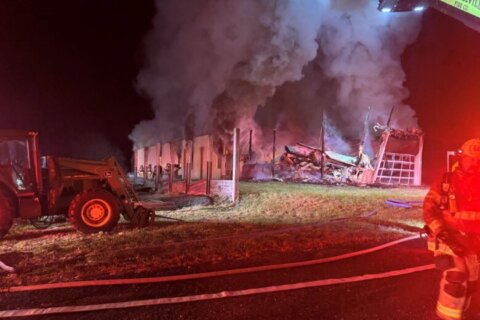This article was reprinted with permission from Virginia Mercury.
Work is underway to clean up a chemical present in an old landfill in Northern Virginia that can lead to a central nervous system condition, a diagnosis the congresswoman who represents the area had been diagnosed with.
The United States Environmental Protection Agency on Tuesday celebrated $22 million in funding from the federal Bipartisan Infrastructure Law that will go toward cleaning up the Hidden Lane Landfill in Loudoun County known as a Superfund site, a designation identifying heavily polluted areas.
According to the EPA, the 25-acre site was a privately owned landfill north of Route 7 between the Broad Run Farms and Countryside communities adjacent to a floodplain of the Potomac River. The landfill opened in 1971 to accept solid and construction waste, discarded appliances and more before the county closed it down in 1984 by court order, issued the year before.
About five years after the closure, the degreasing solvent trichloroethylene, or TCE, was found in the wells that supplied water to homes in the Broad Run Farms subdivision. The site was added to the Superfund program’s National Priorities List in 2008.
“[TCE] is an acute and long term hazard,” said Adam Ortiz, mid-Atlantic regional administrator for the U.S. Environmental Protection Agency. “In a site like this, with the concentrations that we found, it set off alarm bells. This is real stuff, particularly for pregnant mothers.”
The TCE chemical can be ingested through the air or drinking water. Related health issues include heart problems, numbness and Parkinson’s disease. Parkinson’s shares similarities with progressive supranuclear palsy (PSP), a rare neurological disorder that U.S. Rep. Jennifer Wexton, D-Loudoun, in September revealed she has been diagnosed with and is why she won’t seek reelection to her position. Wexton had initially been diagnosed with Parkinson’s, she said in her September statement.
Following a speech in the U.S. House floor using a text-to-speech assistive technology earlier this month because of the condition — the first time a member of Congress has used it to deliver a floor speech — Wexton spoke using the same method at Tuesday’s announcement.
“One study of the water at Camp Lejeune in North Carolina found that Marine Corps veterans who were exposed to water contaminated with TCE were 70% more likely to develop Parkinson’s disease than Marine Corps veterans who were not exposed to the chemical,” said Wexton, who also submitted a letter in support of the EPA’s proposed rule to regulate TCE , which is still used for cleaning. “I’ve seen firsthand how Parkinson’s and related diseases like my PSP can be devastating for individuals, their families, and the communities around them.”
Hidden Lane
The first step in the project is excavation of the contaminated dirt, a $5 million task that began in February and is expected to wrap up this summer.
Then, design and construction of a $17 million new waterline, the main “deliverable” of the project, will be installed over about five years, with help from the U.S. Army Corps of Engineers’ Baltimore office to connect about 110 homes in the area to a fresh source of water.
“We were relieved to be able to have this round of infrastructure funding to accelerate the cleanup,” Ortiz said. The water line is crucial, Ortiz added, “to make sure that the community can drink from the faucet without fear.”
Since the detection of the TCE, and while the work is being completed, the Virginia Department of Environmental Quality, assisted by the EPA, has been providing homeowners in the area with treatment systems, which will be replaced by the new permanent pipeline.
“We are pleased that decades of work in partnership with EPA to clean up the Hidden Lane Landfill has led to remediation of contamination and construction of a public water line to improve the environment and benefit the Broad Run and Country Side communities,” DEQ spokeswoman Irina Calos said in a statement.
The location will then be eligible for reuse, possibly for solar energy generation or a ball field, said Charlie Root, EPA remedial project manager. A data center would likely not be eligible for the site, although their development has boomed in Loudoun County, because of the way the landfill was closed with “just a soil cover,” Root said.
“I don’t think that would support a big building, like a data center,” Root said. “That’s kind of why there’s been discussion about passive recreational uses for ball fields, or solar panels.”
Superfund sites
Superfund sites’ cleanup is overseen by the EPA with help from the DEQ.
Virginia has 36 sites on the EPA’s website, including the former C&R Battery Company Inc. in Chesterfield that was removed in August 2022, and the Nansemond Ordnance Depot in Suffolk that has been converted into a working logistic center.

“It has just allowed us to move faster than we had before,” Root added.
One project in Virginia that will also be funded by the federal law is the Arrowhead Associates, Inc./Scovill Corp site in Montross, where a business currently sits.
The project has the logistical issue of keeping the business running during cleanup, Root said.
Because of that, using in-situ, or in-place, thermal technology to burn up about 99% of the toxic chemicals in the ground under a building is necessary because of an inability to more cheaply dig up the dirt and take it to a certified landfill processor, like the Hidden Lane project.
“At the Hidden Lane Landfill site, it is a deep excavation, it’s down to about 35 feet,” Root said. “But we were able to do that safely with the setback, we could slope it, so that we could get that work done safely without endangering the workers.”
For the thermal treatment, “there’s lots of electricity needs, we have to build infrastructure to bring in the electricity. … It’s a more intense, more involved technology,” Root said.
However it’s done, Ortiz said it’s “important that you are able to accelerate and remove these hazards.”
“They were determined to be Superfund sites for a reason,” Ortiz said.







